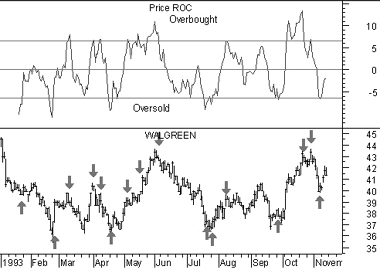
Technical Analysis from A to Z
by Steven B. Achelis
PRICE RATE-OF-CHANGE
Overview
The Price Rate-of-Change ("ROC") indicator displays the difference between the current price and the price x-time periods ago. The difference can be displayed in either points or as a percentage. The Momentum indicator displays the same information, but expresses it as a ratio.
Interpretation
It is a well recognized phenomenon that security prices surge ahead and retract in a cyclical wave-like motion. This cyclical action is the result of the changing expectations as bulls and bears struggle to control prices.
The ROC displays the wave-like motion in an oscillator format by measuring the amount that prices have changed over a given time period. As prices increase, the ROC rises; as prices fall, the ROC falls. The greater the change in prices, the greater the change in the ROC.
The time period used to calculate the ROC may range from 1-day (which results in a volatile chart showing the daily price change) to 200-days (or longer). The most popular time periods are the 12- and 25-day ROC for short to intermediate-term trading. These time periods were popularized by Gerald Appel and Fred Hitschler in their book, Stock Market Trading Systems.
The 12-day ROC is an excellent short- to intermediate-term overbought/oversold indicator. The higher the ROC, the more overbought the security; the lower the ROC, the more likely a rally. However, as with all overbought/over-sold indicators, it is prudent to wait for the market to begin to correct (i.e., turn up or down) before placing your trade. A market that appears overbought may remain overbought for some time. In fact, extremely overbought/oversold readings usually imply a continuation of the current trend.
The 12-day ROC tends to be very cyclical, oscillating back and forth in a fairly regular cycle. Often, price changes can be anticipated by studying the previous cycles of the ROC and relating the previous cycles to the current market.
Example
The following chart shows the 12-day ROC of Walgreen expressed in percent.

I drew "buy" arrows each time the ROC fell below, and then rose above, the oversold level of -6.5. I drew "sell" arrows each time the ROC rose above, and then fell below, the overbought level of +6.5.
The optimum overbought/oversold levels (e.g., ±6.5) vary depending on the security being analyzed and overall market conditions. I selected ±6.5 by drawing a horizontal line on the chart that isolated previous "extreme" levels of Walgreen's 12-day ROC.
Calculation
When the Rate-of-Change displays the price change in points, it subtracts the price x-time periods ago from today's price:
![]()
When the Rate-of-Change displays the price change as a percentage, it divides the price change by price x-time period's ago:
![]()
Contents
- Preface
- Acknowledgments
- Terminology
- To Learn More
- Bibliography
- About the Author
- Technical Analysis
- Price Fields
- Charts
- Support & Resistance
- Trends
- Moving Averages
- Indicators
- Market Indicators
- Line Studies
- Periodicity
- The Time Element
- Conclusion
- Absolute Breadth Index
- Accumulation/Distribution
- Accumulation Swing Index
- Advance/Decline Line
- Advance/Decline Ratio
- Advancing-Declining Issues
- Advancing, Declining, Unchanged Volume
- Andrews' Pitchfork
- Arms Index
- Average True Range
- Bollinger Bands
- Breadth Thrust
- Bull/Bear Ratio
- Candlesticks - Japanese
- CANSLIM
- Chaikin Oscillator
- Commodity Channel Index
- Commodity Selection Index
- Correlation Analysis
- Cumulative Volume Index
- Cycles
- Demand Index
- Detrended Price Oscillator
- Directional Movement
- Dow Theory
- Ease of Movement
- Efficient Market Theory
- Elliott Wave Theory
- Envelopes (Trading Bands)
- Equivolume/Candlevolume
- Fibonacci Studies
- Four Percent Model
- Fourier Transform
- Fundamental Analysis
- Gann Angles
- Herrick Payoff Index
- Interest Rates
- Kagi
- Large Block Ratio
- Linear Regression Lines
- MACD
- Mass Index
- McClellan Oscillator
- McClellan Summation Index
- Median Price
- Member Short Ratio
- Momentum
- Money Flow Index
- Moving Averages
- Negative Volume Index
- New Highs-Lows Cumulative
- New Highs-New Lows
- New Highs/Lows Ratio
- Odd Lot Balance Index
- Odd Lot Purchases/Sales
- Odd Lot Short Ratio
- On Balance Volume
- Open Interest
- Open-10 TRIN
- Option Analysis
- Overbought/Oversold
- Parabolic SAR
- Patterns
- Percent Retracement
- Performance
- Point & Figure
- Positive Volume Index
- Price and Volume Trend
- Price Oscillator
- Price Rate-of-Change
- Public Short Ratio
- Puts/Calls Ratio
- Quadrant Lines
- Relative Strength, Comparative
- Relative Strength Index
- Renko
- Speed Resistance Lines
- Spreads
- Standard Deviation
- STIX
- Stochastic Oscillator
- Swing Index
- Three Line Break
- Time Series Forcast
- Tirone Levels
- Total Short Ratio
- Trade Volume Index
- Trendlines
- TRIX
- Typical Price
- Ultimate Oscillator
- Upside/Downside Ratio
- Upside/Downside Volume
- Vertical Horizonal Filter
- Volatility, Chaikin's
- Volume
- Volume Oscillator
- Volume Rate-of-Change
- Weighted Close
- Williams' Accumulation/Distribution
- Williams' %R
- Zig Zag